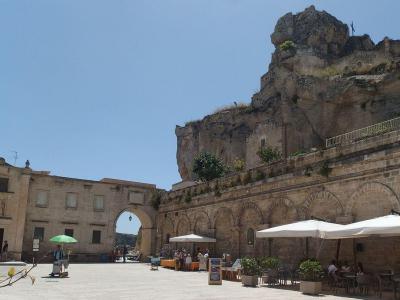Piazza San Pietro Caveoso (San Pietro Caveoso Square), Matera
Saint Pietro Caveoso Square feels like a stage set where Matera’s history and landscape perform together. The square takes its name from the Church of Saints Peter and Paul, built in the 13th century and later dressed up with a Baroque outside and towers. From its perch on the cliff edge, the church commands attention, with the gorge of the Gravina river and the rocky plateau of the Murgia rolling away behind it. The result is a setting where stone, faith, and landscape intertwine.
For centuries, this square carried the rhythm of local life. Religious processions wound their way through it, markets filled the open space, and families from the cave dwellings of Sasso Caveoso mixed with those crossing in from the plateau. The surrounding rock-carved homes and palaces form a kind of natural amphitheater, pressing close around the plaza while opening dramatically toward the ravine. Walk a little further and paths lead into lamias-plain cave houses once shared by farmers, animals, and tools. These were the same dwellings branded as the “shame of Italy” in the 20th century, abandoned in poverty but still haunting in their raw authenticity.
Today, the square serves as both a gathering point and a vantage point. From here you can step toward rock churches like the Madonna of Idris or Saint Lucia alle Malve, or simply pause to take in the layered view of Matera’s past carved into stone. By day, the square is a hub for visitors; by night, the unlit alleys beyond make it better left to guided walks. Saint Pietro Caveoso Square remains a place where Matera’s contrasts-sacred and domestic, ruin and revival-are laid bare in one unforgettable panorama.
For centuries, this square carried the rhythm of local life. Religious processions wound their way through it, markets filled the open space, and families from the cave dwellings of Sasso Caveoso mixed with those crossing in from the plateau. The surrounding rock-carved homes and palaces form a kind of natural amphitheater, pressing close around the plaza while opening dramatically toward the ravine. Walk a little further and paths lead into lamias-plain cave houses once shared by farmers, animals, and tools. These were the same dwellings branded as the “shame of Italy” in the 20th century, abandoned in poverty but still haunting in their raw authenticity.
Today, the square serves as both a gathering point and a vantage point. From here you can step toward rock churches like the Madonna of Idris or Saint Lucia alle Malve, or simply pause to take in the layered view of Matera’s past carved into stone. By day, the square is a hub for visitors; by night, the unlit alleys beyond make it better left to guided walks. Saint Pietro Caveoso Square remains a place where Matera’s contrasts-sacred and domestic, ruin and revival-are laid bare in one unforgettable panorama.
Want to visit this sight? Check out these Self-Guided Walking Tours in Matera. Alternatively, you can download the mobile app "GPSmyCity: Walks in 1K+ Cities" from Apple App Store or Google Play Store. The app turns your mobile device to a personal tour guide and it works offline, so no data plan is needed when traveling abroad.
Piazza San Pietro Caveoso (San Pietro Caveoso Square) on Map
Sight Name: Piazza San Pietro Caveoso (San Pietro Caveoso Square)
Sight Location: Matera, Italy (See walking tours in Matera)
Sight Type: Attraction/Landmark
Guide(s) Containing This Sight:
Sight Location: Matera, Italy (See walking tours in Matera)
Sight Type: Attraction/Landmark
Guide(s) Containing This Sight:
Walking Tours in Matera, Italy
Create Your Own Walk in Matera
Creating your own self-guided walk in Matera is easy and fun. Choose the city attractions that you want to see and a walk route map will be created just for you. You can even set your hotel as the start point of the walk.
Matera Introduction Walking Tour
Architectural historian Anne Parmly Toxey said the cave areas of Matera had been occupied for at least 3,000 years. Archaeological research shows people lived here since the Paleolithic era, shaping homes and communal spaces directly into the soft limestone. Over centuries, those modest caves expanded into an intricate neighborhood-stone dwellings, churches, and twisting passageways stacked upon... view more
Tour Duration: 2 Hour(s)
Travel Distance: 2.4 Km or 1.5 Miles
Tour Duration: 2 Hour(s)
Travel Distance: 2.4 Km or 1.5 Miles
Matera's Ancient Cave Churches
Within the old city of Matera, there are more than 160 churches. Many of these are actually carved into the soft limestone cliffs lining the Gravina River. There are even some used for pagan rituals. The churches were carved from existing caves and tunnels. More than a few sanctified cave churches have been converted to storage and homes.
A good example to start with is the St. Anthony... view more
Tour Duration: 1 Hour(s)
Travel Distance: 1.7 Km or 1.1 Miles
A good example to start with is the St. Anthony... view more
Tour Duration: 1 Hour(s)
Travel Distance: 1.7 Km or 1.1 Miles





